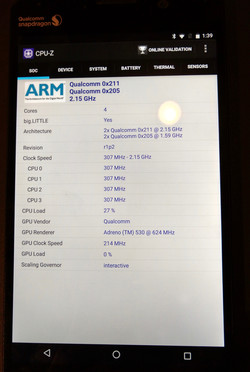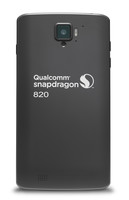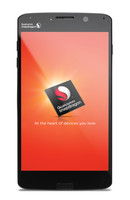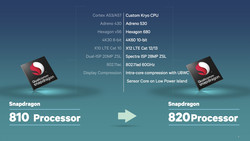Snapdragon 820 im Benchmark-Test
Im Rahmen einer Benchmarking-Veranstaltung von Qualcomm hatten wir die Möglichkeit, die nächste Generation des Spitzenmodells der Qualcomm-Snapdragon-SoCs zu testen. Der Snapdragon 820 war verbaut in einer mobilen Entwicklungsplattform von Qualcomm. Dieses überdimensionale Smartphone ist gedacht für Hardware- und Software-Entwickler und natürlich für die interne Verwendung. Fertige Produkte mit dem Snapdragon 820 werden erst im ersten Halbjahr 2016 erwartet. Die MDP/S (Mobile Development Platform Smartphone) ist laut Qualcomm noch in einem relativ frühen Zustand, und dadurch sind die Benchmarks noch mit etwas Vorsicht zu genießen. Weiters ist das Gehäuse relativ dick, wodurch in schmaleren und kleineren Smartphones ebenfalls durch thermische Limits eine unterschiedliche Performance erreicht werden könnte.
Prozessorkerne

Bei den Prozessorkernen setzt Qualcomm auf vier neu entwickelte Kryo Kerne mit voller Kompatibilität zum ARMv8-ISA-Befehlssatz. Diese sind in zwei Cluster aufgeteilt, die unterschiedlich getaktet werden können. Der Performance Cluster taktet mit bis zu 2,15 GHz und der Stromspar-Cluster mit bis zu 1,6 GHz. Dies ist ähnlich zum big.LITTLE Konzept von ARM. Mehr Informationen zu den Prozessorkernen finden Sie auf unserer Benchmark-Seite zum Snapdragon 820 MSM8996 SoC.
In unseren Benchmarks mit dem MDP zeigen die neuen CPU-Kerne eine hervorragende Leistung. Der alte Snapdragon 810 (z. B. im OnePlus 2 als v2) kann in allen Tests hinter sich gelassen werden. Dies wird möglich durch die starke Einzelkern-Performance, die auf dem Niveau eines Apple-A9-Kernes liegt. In Multi-Threading-Tests kann der A9 durch den Einsatz aller vier Kerne leicht abgehängt werden. Der höhergetaktete A9x im iPad Pro bleibt aber in beiden Bereichen deutlich voran. Der schnelle Exynos 7420 Octa (z. B. im Galaxy S6) kann sich in manchen Tests durchsetzen (Smartbench oder 3DMark Physiktest), im Geekbench ist er jedoch langsamer.
Das Konzept des Quad-Cores mit zwei schnellen und zwei stromsparenden Kernen scheint in den Benchmarks aufzugehen. Selbst bei Tests, die alle Kerne auslasten können, muss sich der S820 nicht verstecken, und die hohe Einzelkern-Performance sollte in täglichen Anwendungen einen deutlichen Vorteil bringen.
Browser Performance
Die Geschwindigkeit der Webtests ist immer stark abhängig von den verwendeten Webbrowsern. Auf dem MDP waren zwei Browser vorinstalliert. Ein aktueller (aber für den Snapdragon 820 klarerweise noch nicht optimierter) Chrome 44 und ein von Qualcomm optimierter Build von Chromium. Bei den Web-Benchmarks haben wir beide laufen lassen und teilweise sehr große Unterschiede festgestellt. Grundsätzlich können jedoch die Top Android Smartphones mit Snapdragon 810 oder Exynos 7420 abgehängt werden. iPhone 6s und iPad Pro mit Safari sind durch die perfekte Anpassung von Browser, Plattform und SoC aus eigenem Haus jedoch noch deutlich besser.
| Geekbench 3 | |
| 64 Bit Single-Core Score (nach Ergebnis sortieren) | |
| Qualcomm Snapdragon 820 MDP | |
| OnePlus 2 | |
| Samsung Galaxy S6 Edge+ | |
| Apple iPad Pro 12.9 | |
| Apple iPhone 6S Plus | |
| NVIDIA Shield TV Console | |
| 64 Bit Multi-Core Score (nach Ergebnis sortieren) | |
| Qualcomm Snapdragon 820 MDP | |
| OnePlus 2 | |
| Samsung Galaxy S6 Edge+ | |
| Apple iPad Pro 12.9 | |
| Apple iPhone 6S Plus | |
| NVIDIA Shield TV Console | |
| 3DMark | |
| 1280x720 offscreen Ice Storm Unlimited Physics (nach Ergebnis sortieren) | |
| Qualcomm Snapdragon 820 MDP | |
| OnePlus 2 | |
| Samsung Galaxy S6 | |
| Samsung Galaxy S6 Edge+ | |
| Apple iPad Pro 12.9 | |
| Apple iPhone 6S Plus | |
| Tegra X1 Reference Platform | |
| 2560x1440 Sling Shot Extreme (ES 3.1) Physics (nach Ergebnis sortieren) | |
| Qualcomm Snapdragon 820 MDP | |
| OnePlus 2 | |
| Samsung Galaxy S6 Edge+ | |
| Apple iPad Pro 12.9 | |
| Apple iPhone 6S Plus | |
| AndEBench | |
| Java (nach Ergebnis sortieren) | |
| Qualcomm Snapdragon 820 MDP | |
| OnePlus 2 | |
| Native (nach Ergebnis sortieren) | |
| Qualcomm Snapdragon 820 MDP | |
| OnePlus 2 | |
| ANDEBench PRO | |
| Platform (nach Ergebnis sortieren) | |
| Qualcomm Snapdragon 820 MDP | |
| OnePlus 2 | |
| Tegra X1 Reference Platform | |
| CoreMark-PRO/HPC (Base) (nach Ergebnis sortieren) | |
| Qualcomm Snapdragon 820 MDP | |
| OnePlus 2 | |
| Tegra X1 Reference Platform | |
| BaseMark OS II - System (nach Ergebnis sortieren) | |
| Qualcomm Snapdragon 820 MDP | |
| OnePlus 2 | |
| Samsung Galaxy S6 Edge+ | |
| Apple iPad Pro 12.9 | |
| Apple iPhone 6S Plus | |
| Smartbench 2012 - Productivity Index (nach Ergebnis sortieren) | |
| Qualcomm Snapdragon 820 MDP | |
| OnePlus 2 | |
| Samsung Galaxy S6 | |
| Samsung Galaxy S6 Edge+ | |
| Browsermark - 2.1 (nach Ergebnis sortieren) | |
| Qualcomm Snapdragon 820 MDP | |
| OnePlus 2 | |
| Samsung Galaxy S6 Edge+ | |
| Apple iPad Pro 12.9 | |
| Apple iPhone 6S Plus | |
| Mozilla Kraken 1.1 - Total (nach Ergebnis sortieren) | |
| Qualcomm Snapdragon 820 MDP | |
| Qualcomm Snapdragon 820 MDP | |
| OnePlus 2 | |
| Samsung Galaxy S6 Edge+ | |
| Apple iPad Pro 12.9 | |
| Apple iPhone 6S Plus | |
| Octane V2 - Total Score (nach Ergebnis sortieren) | |
| Qualcomm Snapdragon 820 MDP | |
| Qualcomm Snapdragon 820 MDP | |
| OnePlus 2 | |
| Samsung Galaxy S6 | |
| Samsung Galaxy S6 Edge+ | |
| Apple iPad Pro 12.9 | |
| Apple iPhone 6S Plus | |
| BaseMark OS II - Web (nach Ergebnis sortieren) | |
| Qualcomm Snapdragon 820 MDP | |
| OnePlus 2 | |
| Samsung Galaxy S6 Edge+ | |
| Apple iPad Pro 12.9 | |
| Apple iPhone 6S Plus | |
| Vellamo 3.x - Browser (nach Ergebnis sortieren) | |
| Qualcomm Snapdragon 820 MDP | |
| Qualcomm Snapdragon 820 MDP | |
| OnePlus 2 | |
| Samsung Galaxy S6 Edge+ | |
| NVIDIA Shield Tablet LTE P1761 | |
| NVIDIA Shield Tablet LTE P1761 | |
* ... kleinere Werte sind besser
Grafik-Performance
Über die neue Adreno 530 sind nur wenige Details bekannt. Qualcomm rühmt sich mit gesteigerter Leistung und Effizienz. Alle modernen Befehlssätze für Smartphones (wie OpenGL ES 3.1 + AEP in Marshmallow) werden unterstützt. Wie immer gibt es alle Details und aktuelle Benchmarks aller Testgeräte auf unserer GPU-Seite des Qualcomm Adreno 530.
In unseren Benchmarks mit dem Referenzsystem von Qualcomm zeigt sich bei der Grafik ein interessantes Bild: Neue und anspruchsvolle Benchmarks können die Adreno 530 voll auslasten und hervorragende Ergebnisse zeigen. Bei älteren Grafiktests schwindet jedoch der große Vorsprung etwas.
Bis auf die etwas enttäuschenden Ergebnisse im relativ anspruchslosen 3DMark Ice Storm kann sich die Grafikkarte gegen die Adreno 430 im S810, die Mali-T760MP8 im Exynos und die PowerVR GT7600 in den neuen iPhones durchsetzen. Schneller ist eigentlich nur der riesige Grafikchip im Apple A9X (iPad Pro) und Tegra X1 (jedoch fehlen uns hier noch die Testergebnisse vom neuen Pixel C).
| GFXBench - 1920x1080 Car Chase Offscreen (nach Ergebnis sortieren) | |
| Qualcomm Snapdragon 820 MDP | |
| OnePlus 2 | |
| Apple iPad Pro 12.9 | |
| GFXBench 3.1 - 1920x1080 Manhattan ES 3.1 Offscreen (nach Ergebnis sortieren) | |
| Qualcomm Snapdragon 820 MDP | |
| Sony Xperia Z5 | |
| ZTE Axon Elite | |
| OnePlus 2 | |
| Apple iPad Pro 12.9 | |
| Apple iPhone 6S Plus | |
| NVIDIA Shield Tablet LTE P1761 | |
| GFXBench 3.0 - 1920x1080 1080p Manhattan Offscreen (nach Ergebnis sortieren) | |
| Qualcomm Snapdragon 820 MDP | |
| Sony Xperia Z5 | |
| ZTE Axon Elite | |
| OnePlus 2 | |
| Samsung Galaxy S6 | |
| Samsung Galaxy S6 Edge+ | |
| Apple iPad Pro 12.9 | |
| Apple iPhone 6S Plus | |
| Tegra X1 Reference Platform | |
| NVIDIA Shield TV Console | |
| NVIDIA Shield Tablet LTE P1761 | |
| NVIDIA Shield Tablet P1761W | |
| GFXBench (DX / GLBenchmark) 2.7 - 1920x1080 T-Rex Offscreen (nach Ergebnis sortieren) | |
| Qualcomm Snapdragon 820 MDP | |
| Sony Xperia Z5 | |
| ZTE Axon Elite | |
| OnePlus 2 | |
| Samsung Galaxy S6 | |
| Apple iPad Pro 12.9 | |
| Apple iPhone 6S Plus | |
| Tegra X1 Reference Platform | |
| NVIDIA Shield Tablet LTE P1761 | |
| NVIDIA Shield Tablet P1761W | |
| Lightmark - 1920x1080 1080p (nach Ergebnis sortieren) | |
| Qualcomm Snapdragon 820 MDP | |
| OnePlus 2 | |
| Samsung Galaxy S6 Edge+ | |
| Tegra X1 Reference Platform | |
| NVIDIA Shield Tablet LTE P1761 | |
| NVIDIA Shield Tablet P1761W | |
| 3DMark | |
| 2560x1440 Sling Shot Extreme (ES 3.1) Graphics (nach Ergebnis sortieren) | |
| Qualcomm Snapdragon 820 MDP | |
| Sony Xperia Z5 | |
| ZTE Axon Elite | |
| OnePlus 2 | |
| Samsung Galaxy S6 Edge+ | |
| Apple iPad Pro 12.9 | |
| Apple iPhone 6S Plus | |
| 2560x1440 Sling Shot OpenGL ES 3.0 Graphics (nach Ergebnis sortieren) | |
| Sony Xperia Z5 | |
| ZTE Axon Elite | |
| OnePlus 2 | |
| Samsung Galaxy S6 Edge+ | |
| Apple iPad Pro 12.9 | |
| Apple iPhone 6S Plus | |
| 1280x720 offscreen Ice Storm Unlimited Graphics Score (nach Ergebnis sortieren) | |
| Qualcomm Snapdragon 820 MDP | |
| Sony Xperia Z5 | |
| ZTE Axon Elite | |
| OnePlus 2 | |
| Samsung Galaxy S6 | |
| Samsung Galaxy S6 Edge+ | |
| Apple iPad Pro 12.9 | |
| Apple iPhone 6S Plus | |
| Tegra X1 Reference Platform | |
| NVIDIA Shield Tablet P1761W | |
| ANDEBench PRO - 3D (nach Ergebnis sortieren) | |
| Qualcomm Snapdragon 820 MDP | |
| OnePlus 2 | |
| Tegra X1 Reference Platform | |
| NVIDIA Shield Tablet P1761W | |
| Basemark X 1.1 | |
| High Quality (nach Ergebnis sortieren) | |
| Qualcomm Snapdragon 820 MDP | |
| OnePlus 2 | |
| Samsung Galaxy S6 | |
| Samsung Galaxy S6 Edge+ | |
| NVIDIA Shield Tablet P1761W | |
| Medium Quality (nach Ergebnis sortieren) | |
| Qualcomm Snapdragon 820 MDP | |
| OnePlus 2 | |
| Samsung Galaxy S6 | |
| Samsung Galaxy S6 Edge+ | |
| NVIDIA Shield Tablet P1761W | |
| Smartbench 2012 - Gaming Index (nach Ergebnis sortieren) | |
| Qualcomm Snapdragon 820 MDP | |
| Sony Xperia Z5 | |
| ZTE Axon Elite | |
| OnePlus 2 | |
| Samsung Galaxy S6 | |
| Samsung Galaxy S6 Edge+ | |
| NVIDIA Shield Tablet P1761W | |
Speicher-Performance
Auch bei der Speicher- und Flash-Performance zeigt das MDP von Qualcomm mit dem Snapdragon 820 keine Schwächen und kann z. B. im BaseMark OS II Memory Test das iPad Pro einholen.
| ANDEBench PRO | |
| Memory Latency (nach Ergebnis sortieren) | |
| Qualcomm Snapdragon 820 MDP | |
| OnePlus 2 | |
| Tegra X1 Reference Platform | |
| NVIDIA Shield Tablet P1761W | |
| Memory Bandwidth (nach Ergebnis sortieren) | |
| Qualcomm Snapdragon 820 MDP | |
| OnePlus 2 | |
| Tegra X1 Reference Platform | |
| NVIDIA Shield Tablet P1761W | |
System Performance
Bei der gesamten System Performance gelingt es dem Snapdragon 820 ebenfalls, den 810er hinter sich zu lassen. Im neuen Antutu v6 dürfte es mit den 131.000 Punkten für einen Spitzenplatz reichen. Laut Antutu.com führt hier derzeit der A9 in Smartphones mit 123.600 Punkten. Der A9x im großen iPad Pro ist in unseren Tests jedoch noch deutlich schneller. Auch der Exynos 7420 bzw. Snapdragon 810 ist mit ungefähr 80.000 Punkten weit hinten.
Auch der Quadrant zeigt eine ähnliche Reihenfolge, wo sich 810 und Exynos hinten einreihen. Auch beim BaseMark OS II Gesamt-Score kann sich nur der A9x durchsetzen. Im AndeBench ist zwar überraschenderweise der Tegra X1 und sogar K1 vorne, jedoch zeigt das Gesamtbild über alle Benchmarks eine überragende Leistung für den Snapdragon 820.
| Smartbench 2012 - Productivity Index (nach Ergebnis sortieren) | |
| Qualcomm Snapdragon 820 MDP | |
| OnePlus 2 | |
| Samsung Galaxy S6 | |
| Samsung Galaxy S6 Edge+ | |
| NVIDIA Shield Tablet P1761W | |
| Quadrant Standard Edition 2.0 - --- (nach Ergebnis sortieren) | |
| Qualcomm Snapdragon 820 MDP | |
| OnePlus 2 | |
| Samsung Galaxy S6 Edge+ | |
| NVIDIA Shield Tablet P1761W | |
| ANDEBench PRO - Device Score (nach Ergebnis sortieren) | |
| Qualcomm Snapdragon 820 MDP | |
| OnePlus 2 | |
| Tegra X1 Reference Platform | |
| NVIDIA Shield Tablet P1761W | |
| AnTuTu v6 - Total Score (nach Ergebnis sortieren) | |
| Qualcomm Snapdragon 820 MDP | |
| OnePlus 2 | |
| Samsung Galaxy S6 | |
| Apple iPad Pro 12.9 | |
| Apple iPhone 6S Plus | |
| NVIDIA Shield Tablet LTE P1761 | |
| PCMark for Android - Work performance score (nach Ergebnis sortieren) | |
| Qualcomm Snapdragon 820 MDP | |
| OnePlus 2 | |
| Samsung Galaxy S6 Edge+ | |
Fazit
Die ersten Eindrücke vom neuen Qualcomm Snapdragon 820 sind ausgewiesen positiv. In der Mobilen Development Plattform (MDP) von Qualcomm, die wohl mit einem kleinen Tablet vergleichbar ist, gab es keinerlei Hitze- oder Throttling-Probleme in unseren Tests. Die Benchmarks sind durch die Bank, trotz des frühen Entwicklungsstadiums, hervorragend. Der alte Snapdragon 810 kann deutlich abgehängt werden, und auch die aktuelle Referenz im Android Segment Samsung Exynos 7420 Octa bleibt meistens hinter dem S820. In der ARM Welt befindet sich daher weiterhin nur der A9X wirklich vor dem Snapdragon 820, dieser wird jedoch auch nur im großen iPad Pro eingesetzt.
Spannend wird es im 1. Halbjahr 2016, wenn erste Endgeräte mit dem Snapdragon 820 erscheinen. Dann wird sich zeigen, ob die Performance in Smartphones vergleichbar bleibt und der S820 sich als schnellster Android SoC rühmen darf. Wenn es keine groben Throttling-Probleme gibt, wird er aber sicher einer der besten Android SoCs sein.
Wie immer empfehlen wir einen Blick auf unsere Benchmark-Seiten des Snapdragon 820 und der Adreno 530, die immer gewartet werden und die neuesten Benchmarks beinhalten.




